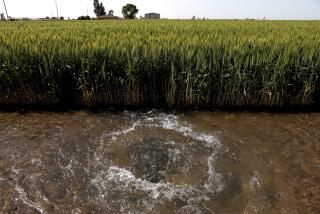Suit pits sucker fish habitat against Inland Empire water rights
A federal plan to preserve more than 9,000 acres of river habitat so that the threatened Santa Ana sucker fish can fulfill its complex life cycle has run into stiff resistance from critics who say it jeopardizes development and water supplies in the Inland Empire.
Two cities and 10 water districts have sued the U.S. Fish and Wildlife Service in U.S. District Court over the agency’s decision to preserve the habitat. They say that it imposes restrictions on water conservation, groundwater recharge and flood control operations that affect water supplies for 1 million residents, and that it threatens plans to sell Santa Ana River water to thirsty communities elsewhere.
Environmental groups led by the Center for Biological Diversity, CalTrout, the Sierra Club and the Audubon Society responded by filing petitions to intervene in the case on behalf of the federal agency. A hearing on the case has been scheduled for February.
The suckers, which scientists know as Catostomus santaanae, were once abundant across Southern California. They have mottled gray backs and silver bellies, grow to about 5 inches in length and have large, thick lips and small mouths that suck up algae and other organisms. Critics of the federal plan have dubbed the sucker “Southern California’s delta smelt,” a reference to a protected 2-inch fish whose movements restrict the pumping operations of the state’s biggest water projects in the Sacramento-San Joaquin Delta.
The plan to save the Santa Ana sucker involves designating critical habitat areas, which would then require federal agencies to consult with the Fish and Wildlife Service before they carry out, fund or authorize any action that could destroy or alter the protected zones. An independent analysis conducted on behalf of the Fish and Wildlife Service showed that costs related to preserving and managing the habitat could range from about $14 million to $450 million over 20 years.
The legal dispute began after the agency designated 9,331 acres of critical habitat in rivers, creeks and washes in Los Angeles, San Bernardino and Riverside counties. The 2010 action was an attempt to resolve a decade-long legal dispute with environmentalists over the fate of the sucker, which evolved in regional flood cycles thousands of years ago.
Of particular concern are northern reaches of the 96-mile-long Santa Ana River system that environmentalists contend must be protected so that seasonal ebbs and flows can move gravel to downstream spawning grounds.
Scott Sobiech, deputy field supervisor for the Fish and Wildlife Service, said the Santa Ana River “is no longer the free-flowing perennial it used to be, and since the fish was listed as a threatened species in 2000, its numbers have continued to decline in the fragmented habitat it persists in.”
Opponents argue that some areas designated as critical habitat are dry for most of the year and therefore of no help to the sucker. They also say the designation could threaten rights to water behind the 6-year-old Seven Oaks Dam near Highland. Seven Oaks currently serves as a flood control facility, but local water districts have expressed interest in storing water there for urban uses.
“Our concern is that water used for people could be thrown down the river in a last-ditch attempt to save the fish, and we can’t let that happen,” said Douglas Headrick, general manager of the San Bernardino Valley Municipal Water District. “The agency’s designation is based on a backroom settlement with environmental groups. The public deserves and expects more than that.”
Adam Lazar, attorney for the Center for Biological Diversity, said the designation would not curtail water supplies. “I believe the opponents’ real concern is to build water projects for homes, businesses and industries that don’t yet exist, and to sell water to Los Angeles and San Diego and other districts that desperately want it,” Lazar said.
More to Read
Sign up for Essential California
The most important California stories and recommendations in your inbox every morning.
You may occasionally receive promotional content from the Los Angeles Times.











